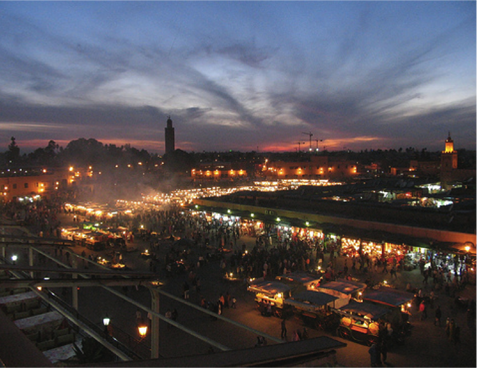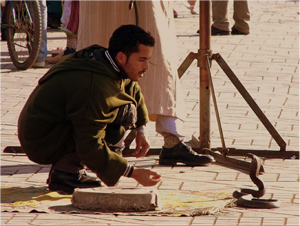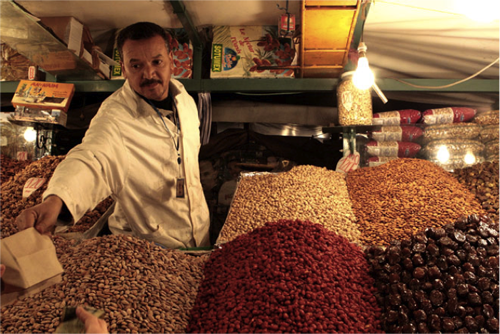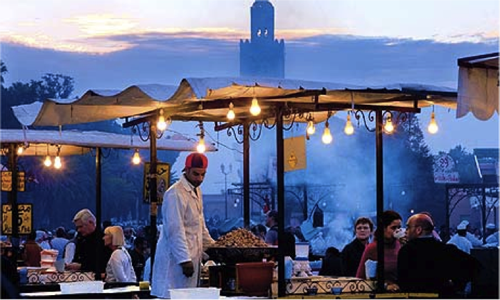
Jemaa El F'na Square is one of the most tolerant pieces of real estate in the world. Here is my account of a recent passage through the open-doored crossroads of Africa.
We ease through traffic past orange blossoms and hibiscus, over to the nerve center of the city, the dusty Vanity Fair known as Jemaa El F'na square. Of course it is not in any way shaped like a square (it is more like a crushed and bent rhomboid), but it is from this open mandala that the souks radiate. We park just beyond its borders, as within no cars are allowed. It was once a bus station, and featured in the Alfred Hitchcock film, The Man Who Knew Too Much (with James Stewart and Doris Day) ...the opening murder takes place here. Before that it was a place of public executions, where heads of criminals were lopped off and placed on stakes, up until the early 20th century.
The spectacles remain lurid and exotic, though less gory. It is the convention hall, wide umbrellas delineating booths, for small merchants, fortune tellers, musicians, water sellers (in signature jangling wide hats), snake charmers, monkey masters and mad men, both those who excel in the art of selling, and those who have lost their minds, and in either case I think I qualify for all-access-badge status. We pass orange juice barrows, henna tattoo makers, places where we can eat grilled meat, spikes and snails. Bikes and horse-drawn carriages and carts slide by; scooters buzz, often steered by young women wrapped in hijabs, head-scarves the devout wear as an affirmation of identity and modesty. They often cross paths with their sisters in high heels and tailored suits. Some of the men in long jalabas sport starched white shirts and ties showing at the neck; others have the pointed yellow leather slippers right out of the Arabian Nights showing below the hem.

Most of all, this place is a gathering of people of all sorts, a giant coffee shop...tourists (almost all of whom are wrapped in sunglasses), locals (most of whom do not, though many of the women shade with veils), salesmen, shoppers, and people from all over Africa and the world. For many here the rub and rancor of multiculturalism manifests itself in a kind of easy tolerance, even within the official bounds of religion and tradition. A saying here goes: "Nothing is true; all is permissible."
Rising above us, just beyond the square, is the pink-stoned, 253'-high Koutoubia minaret, built by the Almohads at the end of the 12th century, and a twin tower to the Giralda in Seville. It is, Hamza, my guide, says, an example of Hispanic-Arabic architecture, topped with four golden balls of decreasing size, symbolizing the sun, the moon and the stars. The orbs were allegedly made from the melted down jewelry of Sultan Yacoub el Mansour's wife, in penance for her having eaten three grapes during Ramadan.
The minaret's name comes from a book market (Koutoub) that once thrived at its base, but is now gone, a fate perhaps similar to Barnes & Noble to the Kindle. The site of the mosque is itself historic, having been originally occupied by a late 11th-century Kasbah, the Almoravid Dar el Hajar (House of Stone). The victorious Almohads destroyed much of the Almoravid city they found. In 1147 they built a large mosque, close to the Dar el Hajar fortress. This they had to do, as no Almohad would pray in a building put up by the heretic Almoravids. Unfortunately, the orientation of the new Almohad mosque was not quite right - the focal point in a mosque, indicated by the mihrab, or prayer niche, should be in the direction of Mecca, and it was discovered to be off. The solution was to build a second mosque - the present Koutoubia - even though the faithful at prayer could correct the directional problem themselves, under the direction of the imam. And there is also a white koubba, the Tomb of Lalla Zohra, the daughter of a freed slave who, as legend has, transformed into a dove each night.
Just to the north of the square we duck through a scalloped doorway, a bab in Arabic, into the mottled and crooked alleyways of the medina. It's like stepping through a time tunnel, into an ancient oriental chiaroscuro. The low-watt florescence lights, the sweet edgy smells, the greetings with hands so dry they feel like crushed autumn leaves. These arteries pulse with conversation and commerce. I yield to so many brilliant sights that my eyes, accustomed to copy-cat shopping malls, jam and overload.
"Dark, fierce and fanatical are these narrow souks of Marrakech," Edith Wharton wrote in 1919. "Marrakech is the great market of the south...not only the Atlas with its feudal chiefs and their wild clansman, but all that lies beyond of heat and savagery: the Sahara of the veiled Touaregs, Dakka, Timbuctoo, Senegal and the Soudan."
We find our way to the olive market, where casts and bowls and pyramids of the black and green fruit of Olea europaea tempt a taste, or the urge to knock something over, which I almost do when a vendor invites me to duck under his shelf to enter his stall and look around. It's all organic and local here, with more variety than Whole Foods (and considerably better prices).

The medina has a striking sense of fractured space, time and culture. All is motion....walking, buying, selling, exchanging. The canyons and couloirs are so packed with people, animals and objects that one has to learn a new way to navigate. Those who live or trade here don't so much walk as glide, ready at an instant to dodge to the right or left to avoid a pile of oncoming hides, a blind beggar, or a cart erupting with produce.
We pass the shoe market, where hundreds of shoes hang from the ceilings on strings; the purse market, hanging by purse strings; the music mart, where the rich interdental consonants of Arabic songs consume the air; the basket bazaar; a merchant unfurling a yo-yo. In the copper souk we watch the metal worked by craftsmen tapping with their legs crossed, faces set in vital concentration. The Laghzal Souk is home to the wool merchants. The el Btana to the sheepskin sellers. These are the works of Adam, the Arabic word for human, who was created by the divine craftsman, Allah. But over there is Eve...In one stall veiled women press around the stacks of underwear stalls, fingering lace and frilly wear. I can't tell their age for their coverage...they might be teens or middle-aged or septuagenarians, or some combination. At another stand there are racks of colored cell phones for sale, but nobody seems to be buying.
The spice market is a must-smell. The atmosphere is thick with scents that battle each other in the nose--the sharp sour smoke of tobacco, the perfumes of spices and teas...it is a mélange of snaking Arabic sounds and old scents: the tang of saffron, cumin, black pepper, ginger, verbena, cloves and orange flower. Among sacks of salted almonds, ground nuts and chick peas are piled high like mountains, alongside baskets of dates, and, on the apothecaries' shelves, pots of henna, vials of ghassoul clay (used as a traditional beauty treatment), flasks of rose extract, jasmine, mint, kohl, pieces of amber and smalls bottles of something called argan oil.
We wind about beneath a trellis-work of reeds and fall into the black magic market, where dried lizards, pythons, crocodiles, turtles, hedgehogs, lynx and unidentifiable creatures are chopped and minced and mixed with indecipherable spices to create elixirs, nostrums and potions to cast spells, to aid in fertility and virility, and here even cure intolerance. Hamza shows me a chunk of resin from a tree in the Sahara called um nnass, which he says women use to make their husbands love them more, by burning as in incense or mixing into a drink "without the other person even knowing."
In the Zarbia souk men in flowing jalabas hawk carpets, pouffes, babouches (the popular heelless leather slippers) and brocades. I get lost among the cornucopias of chotkies and tat, and am somehow spilled back out to the main Jemaa El F'na Square, where one charmeurs de serpent pulls me under his black umbrella and wags his head at his Egyptian Cobra (actually, Naja haje legionis, a sub-species found in southern Morocco) as his associate blows his bagpipe-like melody in his ghaita. The big black snake promptly flares its hood and snaps the embroidered beige skull cap off the charmer's head, as the flute-like instrument flutters in the background, and a goat-skin hand-drum pounds...pam,pam,pam-pam-pam. Then of course, he wraps the snake around my neck, and lets it flick its tongue at mine as though a kiss....it is drama, and worth a tip.
Location, location, location....the gift of geography gave Morocco its multiculturalism. Lapped by the trade routes of three seas...the Atlantic, the Mediterranean, and the Sahara...here washes the goods, the economics and influences from three continents, Europe, Asia and Africa. To Morocco, the world was flat long before Tom Friedman.
I stumble through a heavy carved wooden door studded with big iron nails and bolts, the hinges, Hamza tells me, a rendering of the five fingers of Fatima. In Morocco the Hand of Fatima is a popular women's talisman (from Arabic tilsamen "to make marks like a magician"), and ranges from literal representations of a hand to highly abstracted designs containing a pattern in five units, for her five fingers. The Hand of Fatima is said to protect brides, pregnant women and newborn children, considered especially vulnerable. Fatima brings healing and compassion, for individuals and nations alike, and helps in achieving forgiveness and understanding.
On the other side of the door I have fallen into a secret place, a riad (which means "garden," but has come to represent houses with courtyards and foundations that have been turned into inns) just a membrane from the clamor of the medina, and am wowed by the contrast. It is the tradition in these parts that beauty should be veiled. The houses of Marrakech are all turned inward; no windows look to the street. To the outside world they present a blank wall, an anonymous door. To their inhabitants they offer fountained courtyards, gorgeous tile work, deep divans, shade, internal peace, and four symmetrical flower beds utterly cloistered from the outside world.
The Koran depicts paradise as four gardens, interpreted as four stages through which the seeker travels on his inward journey toward God. "A garden enclosed is my sister, my spouse; a spring shut up, a fountain sealed" says the Song of Solomon. Many Muslims have taken the holy writings to mean that the veil is an extension of this cloistered space, that the woman, seeing but unseen behind it, moves through teeming life as if sequestered in her own garden.
As the day slips into the evening the square loads with more activity, from acrobats to tooth pullers, healers to hustlers, fortune tellers and storytellers. The tales are tall here...as a local saying goes, "If you're going to tell the truth, you better have one foot in the stirrup."
In one eddy of the square I watch an ensemble of barefooted leaping, spinning Gnawa musicians in their white garments and twirling tasseled caps. Gnawa refers to an ethnic group- religious order descended from former slaves from Sub-Saharan Africa, who marched in caravans that stopped in the Kasbahs on the trade route north, some of whom stayed and assimilated. The last slave caravan, it is said, crossed the Sahara in the 1950s.
The name appears to originate from the Saharan Berber dialect word aguinaw, meaning "black (men)". This word in turn may be derived from the name of a city significant in the 11th century, in what is now western Mali, called Gana, in Arabic Ghana or Jenna and in Portuguese and later French Guinea or Jenné.

Popular history credits the Moroccan Sultan Ahmed Al Mansour Ad-Dahbi's conquest in 1591 of part of the Songhai Empire, in particular Timbuktu, with bringing large numbers of captives and slaves back across the Sahara to form the Gnawa.
While adopting Islam Gnawa continued to celebrate ritual possession devoted to dances of fright. The rite of possession is called Derdba and proceeds the night that is animated jointly by a master musician (maâlem) accompanied by his troupe. Gnawa music mixes classical Islamic Sufism with pre-Islamic African traditions.
A few years ago I produced a project that traced the American Blues trail backwards from Chicago down the Mississippi to New Orleans. It was there I heard the theory that the blues traces back through the Diaspora back to Africa, back to the Gnawa.
In Moroccan popular culture, Gnawas, through their ceremonies, are considered to be experts in the magical treatment of scorpion stings and psychic disorders. They can evoke ancestral saints. They heal diseases, drive out evil, by the use of dance, sound, colors, imagery, perfumes and fright.
I stand in a trance watching the Gnawans play their deeply hypnotic music, marked by low-toned, urgent rhythmic sintir melodies, call and response singing, hand clapping and the shaking of rattle-like cymbals called krakeb. How do they do that voodoo? It's a scene from which I don't want to awaken.